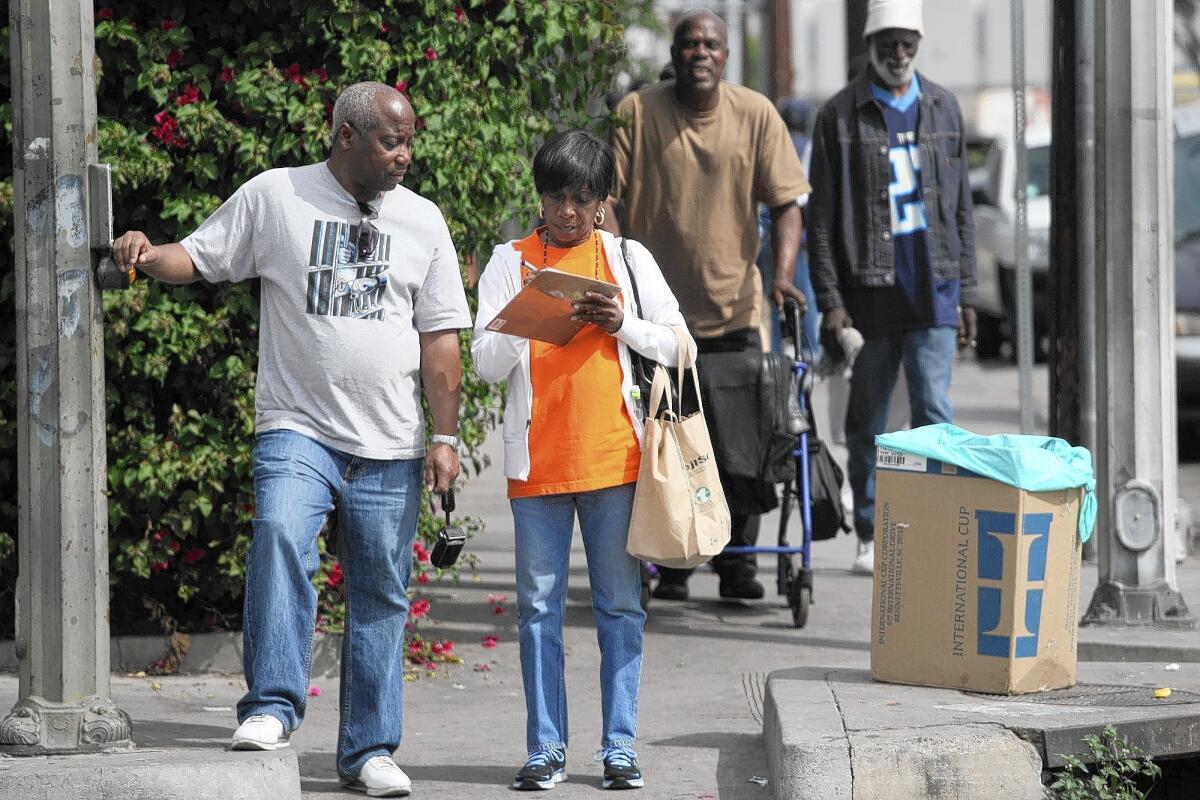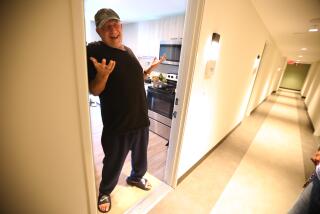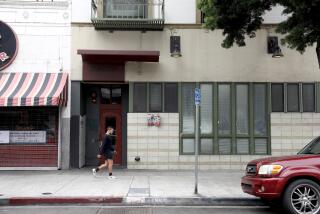The air horn heard around skid row

It was billed as a guided tour for downtown residents, church and business groups and elected officials to see skid row for themselves.
As the group headed out on foot from L.A.’s Midnight Mission, it was confronted by demonstrators whistling, drumming and chanting: “You’re not welcome here!” and “You’re the problem!”
That was in June 2011. A year later, Deborah Burton, a community organizer who was once homeless, was charged with misdemeanor assault and battery on two tour leaders.
Her alleged weapon? An air horn.
A jury acquitted Burton. But she and her group — the Los Angeles Community Action Network — now have launched their own court action, filing a federal civil rights lawsuit against the city, alleging that police have conspired with business leaders to quash protest on skid row.
City Atty. Mike Feuer said the suit had no merit whatsoever, but the story of the noisemaker and the court cases it spawned illustrates the acrimony and mistrust as change comes to the 50-block district.
Once designated an official “containment” zone for homeless people, skid row now is home to a doggie boutique and craft cocktails. Nearby, an estimated 1,000 to 1,500 people live in the streets, and thousands of formerly homeless are in refurbished flophouses and apartments.
Both sides in the legal disputes are seeking many of the same things: safer and cleaner streets, for instance. But they also are in sharp conflict.
Activists want skid row preserved as a haven for poor people; business and political interests see it as downtown’s shiny new frontier.
“While we have a common goal, eliminating homelessness,” said Mai Lee, an executive at the Midnight Mission who was caught up in the case, “we don’t have a common vision.”
The skid row walks were launched in 2005 to help revive interest in the derelict neighborhood.
“When you tuck it away in an area few people experience, the rest of the city doesn’t understand how chronic the problem is,” said Orlando Ward, who worked at the time for the Midnight Mission and is now an executive director of Volunteers of America in Los Angeles.
As the walks drew attention to the area, they also brought its complicated factions to light.
Burton’s group wants to preserve housing for the very poor and stop what it sees as the “criminalization” of skid row residents, and they believe police and business are gentrifiers bent on running the homeless and the poor out of skid row.
“You can’t just herd us away,” said Burton, 62. “We’re not inanimate objects. We’re people.”
Some social service groups and business associations, however, want the homeless off the streets and in shelters or programs.
They backed a cleanup strategy, launched by the LAPD in 2006, that deployed 50 extra officers to the area — targeting crime and quality-of-life infractions such as jaywalking, urinating in public and resting on the sidewalk.
Many oppose expanding housing for the homeless on skid row, which they view as a toxic environment for people clawing their way out of substance abuse, mental illness and poverty.
They see the activists as ideologues and enablers for dysfunctional behavior. They’re “advocates for everybody being able to use drugs, sell drugs, keeping skid row skid row,” said the Rev. Andy Bales of the Union Rescue Mission.
Ward said both camps oversimplify.
“People say it’s just poor people who need a hand up, jobs and housing — well, it’s more complicated than that,” Ward said. “Others say they just want to be there by choice, and it’s more complicated than that.”
The tension increased after the police were successfully challenged twice in court, resulting in limits on the department’s ability to sweep encampments of the homeless or confiscate their unattended belongings.
On June 1, 2011, Estela Lopez — then head of the Central City East Assn., an influential business group — and Lee led a group of several dozen people into skid row. They were flanked by police officers and the business group’s security guards, with the protesters on their heels.
Burton periodically let go a blast from a hand-held air horn. “If you had a protest, there’s noise, songs, spoken word,” she said. “You don’t just stand there and look.”
Burton said she sounded the horn over her head, eight feet from Lopez. Lopez testified later that Burton blasted the horn right in her ear. Lee was captured on videotape bending over and covering her ears.
In its civil rights lawsuit filed in January, Burton’s Community Action Network cited emails between Central City East officials and Lt. Shannon Paulson, in charge of the LAPD’s skid row initiative, as evidence that police and business interests were trying to find a way to prosecute Burton.
Central City East had emailed Paulson, asking that charges be filed against Burton. Paulson responded that prosecution could raise 1st Amendment issues.
On July 2, Paulson emailed Central City East, saying the group needed to identify some people who could “articulate discomfort due to the air horns utilized at the June walk.”
On Nov. 10, 2011, five months after the walk, Lopez for the first time said that Burton had sounded the air horn directly in her ear, the civil rights lawsuit alleged.
Lopez and Paulson, both defendants in the civil rights suit, declined to comment.
Burton was charged with three misdemeanor counts of assault and battery likely to produce “great bodily injury.”
“If you’re using an air horn for legitimate 1st Amendment purposes, that’s one thing,” said Don Steier, lawyer for Central City East, “but that instrument becomes a weapon if used in the wrong way.”
At a trial last summer, Lee testified that she didn’t sustain any lasting injuries. Lopez told the jury that Burton’s blast caused her significant hearing loss, but the defense presented evidence that Lopez had ear problems dating to 1989.
Burton was acquitted on all counts. Feuer declined to discuss the case in detail, but said, “We proceeded … in a highly professional way and handled it as effectively as one could expect.”
The skid row walks are no more. Lopez has joined a lobbying firm and Paulson has transferred out of skid row. Burton’s group and police and business interests remain stuck in an uneasy standoff.
“Anywhere else it would seem absurd,” skid row activist Alice Callaghan said of the prosecution. “But on skid row, it’s like, there they go again.”
More to Read
Sign up for Essential California
The most important California stories and recommendations in your inbox every morning.
You may occasionally receive promotional content from the Los Angeles Times.










